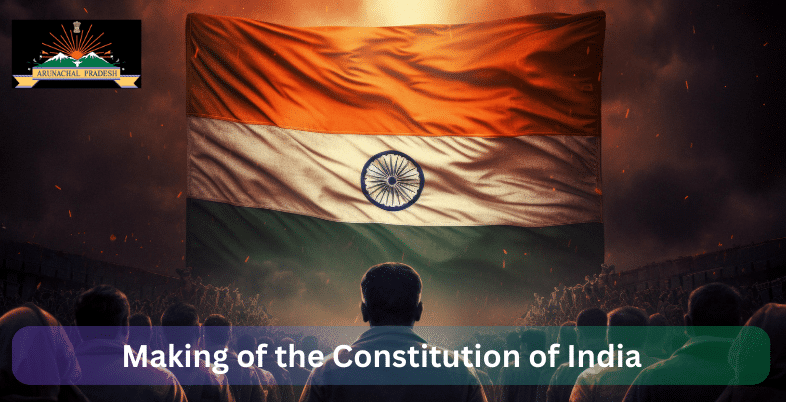1934: MN Roy started demand for a Constituent Assembly
1946: A Cabinet Mission was sent to India. While it rejected the idea of two Constituent Assemblies, it put forth a scheme for the Constituent Assembly which more or less satisfied the Muslim League.
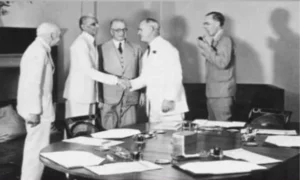
Composition of Constituent Assembly
- The Constituent Assembly was constituted in November 1946 under the scheme formulated by the Cabinet Mission Plan.
- The total strength of the Constituent Assembly was to be 389.
- Of these, 296 seats were to be allotted to British India and 93 seats to the princely states.
- Out of 296 seats allotted to British India, 292 members were to be drawn from the eleven governors’ provinces and four from the four Chief Commissioners’ provinces, one from each.
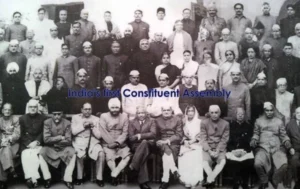
Working of the Constituent Assembly
- The Constituent Assembly held its first meeting on December 9, 1946.
- Dr. Sachchidananda Sinha, the oldest member, was elected as the temporary President of the Assembly.
- Later, Dr. Rajendra Prasad was elected as the President of the Assembly.
- Similarly, HC Mukherjee was elected as the Vice-Presidents of the Assembly.
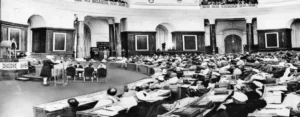
Major Committees
| S. No. | Committee | Presided by |
| 1 | Union Powers Committee | Jawaharlal Nehru |
| 2. | Union Constitution Committee | Jawaharlal Nehru |
| 3. | Provincial Constitution Committee | Sardar Patel |
| 4. | Drafting Committee | Dr B.R. Ambedkar |
| 5. | Advisory Committee on Fundamental Rights, Minorities and Tribal and Excluded Areas. | Sardar Patel |
This committee had the following sub-committees:
- Fundamental Rights Sub-Committee – J.B. Kripalani
- Minorities Sub-Committee – H.C. Mukherjee
iii. North-East Frontier Tribal Areas and Assam Excluded & Partially Excluded Areas Sub-Committee – Gopinath Bardoloi
- Excluded and Partially Excluded Areas (Other than those in Assam) Sub-Committee – A.V. Thakkar
| 6. | Rules of Procedure Committee | Dr Rajendra Prasad |
| 7. | States Committee (Committee for Negotiating with States) | Jawaharlal Nehru |
| 8. | Steering Committee | Dr Rajendra Prasad |
Suggested Read👇🏻
Minor Committees
| S. No. | Committee | Presided by |
| 1. | Committee on the Functions of the Constituent Assembly | G.V. Mavalankar |
| 2. | Order of Business Committee | Dr K.M. Munshi |
| 3. | House Committee | B. Pattabhi Sitaramayya |
| 4. | Ad-hoc Committee on the National Flag | Dr Rajendra Prasad |
| 5. | Special Committee to Examine the Draft Constitution | Alladi Krishnaswamy Ayyar |
| 6. | Credentials Committee | Alladi Krishnaswamy Ayyar |
| 7. | Finance and Staff Committee | Dr Rajendra Prasad |
| 8. | Hindi Translation Committee | |
| 9. | Urdu Translation Committee | |
| 10. | Press Gallery Committee | |
| 11. | Committee to Examine the Effect of the Indian Independence Act of 1947 | |
| 12. | Committee on Chief Commissioners’ Provinces | B. Pattabhi Sitaramayya |
| 13. | Commission on Linguistic Provinces | |
| 14. | Expert Committee on Financial Provisions | |
| 15. | Ad-hoc Committee on the Supreme Court | S. Varadachariar. |
Drafting Committee Members
Chairman – Dr. BR Ambedkar
Members:
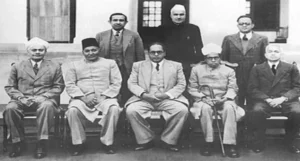
- N Gopalaswamy Ayyangar
- Muhammad Saadullah
- Alladi Krishnaswami Ayyar
- KM Munshi
- BL Mittar substituted by N Madhava Rao following his resignation on health issues
- Dr. DP Khaitan (died in 1948 and was substituted by TT Krishnamachari)
Objectives Resolution
- On December 13, 1946, Jawaharlal Nehru moved the historic ‘Objectives Resolution’ in the Assembly.
- It laid down the fundamentals and philosophy of the constitutional structure.
- This Resolution was unanimously adopted by the Assembly on January 22, 1947.
- It influenced the eventual shaping of the constitution through all its subsequent stages. Its modified version forms the Preamble of the present Constitution.
Other Functions Performed
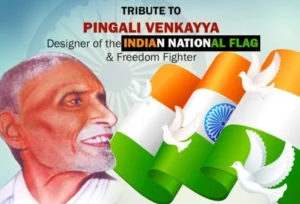
- It ratified India’s membership of the Commonwealth in May 1949.
- It adopted the national flag on July 22, 1947. It was designed by Pingali Venkayya.
- It adopted the national anthem on January 24, 1950.
- It adopted the national song on January 24, 1950.
- It elected Dr. Rajendra Prasad as the first President of India on January 24, 1950.
Enactment of the Constitution
- In all, the Constituent Assembly had 11 sessions over two years, 11 months, and 18 days.
- The Constitution, adopted on 26th November 1949, contained a Preamble, 395 Articles divided into 22 Parts and 8 Schedules.
- The enforcement of the Constitution was delayed till 26th January because, in 1929, on this day, the Indian National Congress demanded Poorna Swaraj in Lahore Session, Chaired by JL Nehru.
- The Constitution came into force on 26th January 1950, known as Republic Day of India.
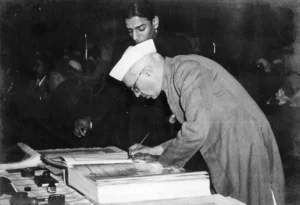
Schedules of the Indian Constitution
Trick to learn-
TEARS OF OLD PM
Some Important Facts
| Symbol ( seal) of the Constituent Assembly | Elephant |
| Constitutional Advisor to the Constituent Assembly | Sir B.N. Rau |
| Calligrapher of the Indian Constitution | Prem Behari Narain Raizada |
| Decoration of Indian Constitution | Shantiniketan including Nand Lal Bose and Beohar Rammanohar Sinha |
| Calligraphy of Hindi version | Vasant Krishan Vaidya |
Different Sources of Constitution
| Country | Part |
| UK |
|
| Erstwhile USSR |
|
| Australia |
|
| USA |
|
| Japan |
|
| Germany |
|
| Canada |
|
| Ireland |
|
| South Africa |
|
| France |
|
Important Constitutional Amendments
| Amendment | Description |
| 1st CAA, 1951 | Added 9th Schedule |
| 7th CAA, 1956 | Deleted 7th Part of the Constitution |
| 36th CAA, 1975 | Sikkim became state |
| 42nd CAA. 1976 | Mini Constitution |
| 44th CAA, 1978 | Right to Property deleted from Fundamental Rights, Article 352 was amended to replace ‘internal disturbance’ with ‘armed rebellion’ |
| 52nd CAA, 1985 | Added Tenth Schedule |
| 55th CAA, 1986 | Arunachal Pradesh became state (w.e.f. 20/02/1987) |
| 56th CAA, 1987 | Goa became state |
| 57th CAA, 1987 | Reservation of Seats for STs of Nagaland, Meghalaya, Mizoram & Arunachal Pradesh |
| 73rd CAA, 1992 | Added Schedule 11 |
| 74th CAA, 1992 | Added Schedule 12 |
| 97th CAA, 2011 | Amendment of Article 19(1)(c), insertion of article 43B, insertion of part 9B for co-operative societies |
| 99th CAA, 2014 | Repealed by SC |
| 101st CAA, 2016 | GST (added Article 279A) |
| 103rd CAA, 2018 | 10% reservation for EWS |
| 105th CAA, 2021 | Restored the power of State Governments and UTs to identify Socially and Economically Backward Classes |
Parts of Constitution
| Part | Trick | Subjects | Articles |
| 1 | U | Union & its Territory | 1-4 |
| 2 | Can | Citizenship | 5-11 |
| 3 | Fly | Fundamental Rights | 12-35 |
| 4 | Directly | DPSPs | 36-51 |
| 4A | from | Fundamental Duties | 51A |
| 5 | U | Union | 52-151 |
| 6 | S | States | 152-237 |
| 7 | to | Deleted by 7th CAA, 1956 | |
| 8 | U | Union territory | 239-242 |
| 9 | P | Panchayati Raj Institutions | 243A-243O |
| 9A | Meet | Municipalities | 243P-243ZG |
| 9B | Clever | Cooperative Societies | 243ZH-243ZT |
| 10 | Shyam | Scheduled and Tribal Areas | 244-244A |
| 11 | Ram | Relation between Union and States | 245-263 |
| 12 | Fruit | Finance, Property, Contracts | 264-300A |
| 13 | Taste | Trade & Commerce | 301-307 |
| 14 | Sweet | Services under Union & States | 308-323 |
| 14A | To | Tribunal | 323A-323B |
| 15 | Eat | Elections | 324-329A |
| 16 | So | Special provisions relating to certain classes | 330-342 |
| 17 | L | Languages | 343-351 |
| 18 | E | Emergency Provisions | 352-360 |
| 19 | M | Miscellaneous | 361-367 |
| 20 | A | Amendment of the Constitution | 368 |
| 21 | T | Temporary, Transitional & Special Provisions | 369-392 |
| 22 | S | Short title, commencement, authoritative text in Hindi & Repeals | 393-395 |
Part 1 to 11 Trick: U Can Fly Directly from US to UP Clever Meet Shyam Ram
Part 12 to 22: Fruit Taste Sweet to Eat So LEMATS

